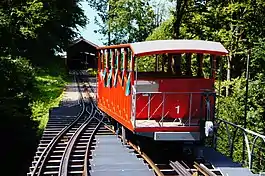Giessbachbahn
The Giessbach Funicular (German: Giessbachbahn)[2] is a historic funicular in the Swiss canton of Bern and municipality of Brienz. It links a landing stage on Lake Brienz, served by shipping services on the lake, to the Grand Hotel Giessbach and Giessbach Falls above. The funicular is owned by the hotel, but since 1983 has been operated by a preservation foundation.[3][4][5]
| Giessbachbahn | |
|---|---|
 Looking downwards, with car and passing loop (2012) | |
| Overview | |
| Other name(s) | Drahtseilbahn Giessbach |
| Status | In operation |
| Locale | Canton of Bern, Switzerland |
| Termini |
|
| Stations | 2 |
| Website | giessbach.ch |
| Service | |
| Type | Funicular |
| Route number | 2470[1] |
| Rolling stock | 2 for 40 passengers each |
| History | |
| Opened | 21 July 1879 |
| New Abt switch | 1891 |
| Technical | |
| Track length | 363 metres (1,191 ft) |
| Number of tracks | 1 with passing loop |
| Rack system | Riggenbach |
| Track gauge | 1,000 mm (3 ft 3+3⁄8 in) |
| Electrification | 1948 (water counterbalancing 1879-1912, Pelton wheel) |
| Highest elevation | 656 m (2,152 ft) |
| Maximum incline | 32% |

Description
The Giessbach funicular was designed by the Swiss engineer Carl Roman Abt. When it was opened in 1879, it was the first funicular with a two-rail single track layout with a relatively short passing loop in the middle.[2] Its turnouts had no moving parts, which was quite a remarkable achievement for the time. Abt had later developed its modification which became known as the Abt Switch.[2]
Originally the funicular was powered by water ballast, and the Riggenbach rack rail in the middle of the track was used for speed control. In 1912 the water ballast system was replaced by a hydraulic engine powered by a Pelton turbine. Which is in its own turn was replaced in 1948 by an electric drive. The rack rail is currently used for emergency braking. The funicular's two wooden cars are restored back to their original appearance in 1879.[2]
In 2015 the funicular was included in the list of Historic Mechanical Engineering Landmarks by the American Society of Mechanical Engineers under number 259.[6]
Characteristics
The main characteristics of system are:[7]
| Feature | Value |
|---|---|
| Number of cars | 2 |
| Number of stops | 2 |
| Configuration | Single track with passing loop |
| Track length | 363 metres (1,191 ft) |
| Rise | 98 metres (322 ft) |
| Maximum gradient | 32% |
| Track gauge | 1,000 mm (3 ft 3+3⁄8 in) |
| Speed | 1.9 metres per second (6.2 ft/s) |
| Journey time | 4 mins |
| Capacity | 40 passengers per car; 480 persons in each direction per hour |
See also
Further reading
- Abt, Roman (1879), "Die Seilbahn am Giessbach", Die Eisenbahn, Le chemin de fer (in German), no. 17–22, pp. 97–99, 103–105, 109–110, 112, 118, 121–123, 127–129, Tafel I–IV
- Abt, Roman (25 October 1897), "Die Seilbahn am Giessbach; Teil 1: Einleitung, Tracé und Unterbau", Die Eisenbahn (in German), vol. 11, no. 17, pp. 97–99, doi:10.5169/SEALS-7729
- Abt, Roman (25 October 1897), "Die Seilbahn am Giessbach; Tafel I: Längeprofil", Die Eisenbahn (in German), vol. 11, no. 17
- Abt, Roman (1 November 1897), "Die Seilbahn am Giessbach; Teil 2: Oberbau", Die Eisenbahn (in German), vol. 11, no. 18, pp. 103–105, Tafel II: Brücke, doi:10.5169/SEALS-7731
- Abt, Roman (8 November 1897), "Die Seilbahn am Giessbach; Teil 3: Hochbau, Bauzeit, Verkehr", Die Eisenbahn (in German), vol. 11, no. 19, pp. 109–110, 112, Tafel III: Kreuzung, Zahnstangenweiche, doi:10.5169/SEALS-7733
- Abt, Roman (15 November 1897), "Die Seilbahn am Giessbach; Teil 4: Wagen", Die Eisenbahn (in German), vol. 11, no. 20, pp. 118, Tafel IV, doi:10.5169/SEALS-7734
- Abt, Roman (22 November 1897), "Die Seilbahn am Giessbach; Teil 5: Wagen, mechanische Einrichtungen", Die Eisenbahn (in German), vol. 11, no. 21, pp. 121–123, doi:10.5169/SEALS-7736
- Abt, Roman (29 November 1897), "Die Seilbahn am Giessbach; Teil 6: Betriebssicherheit, Baukosten, Betriebskosten, Rentabilität", Die Eisenbahn (in German), vol. 11, no. 22, pp. 127–129, doi:10.5169/SEALS-7738
- Abt, Roman (25 October 1897), "Die Seilbahn am Giessbach; Teil 1: Einleitung, Tracé und Unterbau", Die Eisenbahn (in German), vol. 11, no. 17, pp. 97–99, doi:10.5169/SEALS-7729
- Wild, Adolf (2013), Die Standseilbahn am Giessbach (in German), Ad. u. El. Wild-Salvisberg, OCLC 861206078
- Grand Hotel Giessbach, ed. (2015), Giessbach Standseilbahn (PDF) (in German)
References
- "2470: Giessbach See - Giessbach Hotel" (PDF), Fahrplanfelder.ch, Tableaux-horaires.ch (in German), 2022, 2470
- The Giessbach Funicular with the World's First Abt Switch (PDF). The American Society of Mechanical Engineers. 2015.
- Green, Richard (February 2007). "Railways in the Berner Oberland - Part 3". Today's Railways Europe. Platform 5 Publishing Ltd (134).
- map.geo.admin.ch (Map). Swiss Confederation. Retrieved 27 January 2012.
- "Die Giessbachbahn". Seilbahn-Nostalgie (in German). C. Gentil. Retrieved 2 March 2014.
- "Landmarks". American Society of Mechanical Engineers. Retrieved 16 September 2013.
- "61.019 Giessbachbahn, Giessbach, Standseilbahn". Schweizer Seilbahninventar = Inventaire suisse des installations à câbles = Inventario svizzero degli impianti a fune [Swiss Inventory of Cableways] (in German). Federal Office of Culture. Retrieved 3 November 2010.
External links
- Funicular turnout with Abt Switch, first installed at Giessbach 1879, Switzerland — a slide show by the ASME with drawings and diagrams
- Giessbach Bahn page from Funimag
- Grand Hotel Giessbach web site
- "61.019 Giessbachbahn, Giessbach, Standseilbahn". Schweizer Seilbahninventar = Inventaire suisse des installations à câbles = Inventario svizzero degli impianti a fune [Swiss Inventory of Cableways] (in German). Federal Office of Culture. 2011.